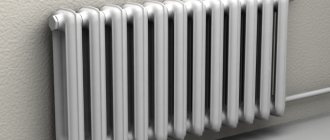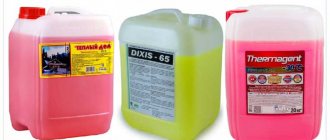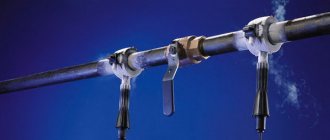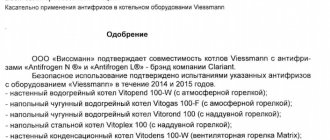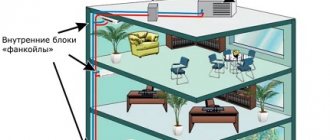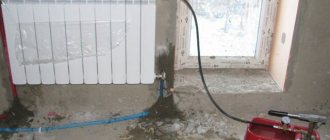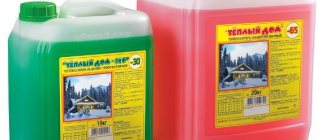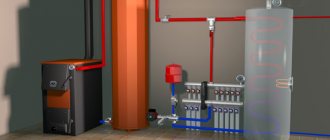Heating maintenance, antifreeze replacement
What is antifreeze replacement?
Replacing antifreeze involves a lot of actions related to heating maintenance. The main effect of this concept is the replacement of water with antifreeze in heating an apartment. This change of water allows you to avoid defrosting the heating system as a whole during the winter season. In another way, changing water can be called introducing a substance into the heating equipment that is not capable of freezing. After the introduction of such a substance, the treated material must be replaced with an updated one. All these actions can only be carried out by an experienced specialist, because replacing heating material is a labor-intensive task that can be performed with dexterity, certain skills and professional training. Antifreezes are considered harmful substances containing toxins. Toxins require careful use because they can expand more than water.
Antifreeze volume calculation
When purchasing expensive anti-freeze units, in order not to overpay, before filling the heating system, you should know the required volume of coolant. The easiest way to accurately determine it is to pump water into the main line with a pressure of 1 - 1.5 bar, and then drain it and measure the resulting amount. You can add 10% to the mass of the liquid for airing and evaporation of the coolant.
V (system) = V (boiler) + V (cistern) + V (batteries) + V (pipes)
The working volume of the boiler and expansion tank is determined from the passport data for the equipment provided by the manufacturer. In the same way, the capacity of radiators is determined from the operating instructions by multiplying the indicators of one section by their number. In the absence or loss of passports for the boiler, hydraulic accumulator or radiator heat exchangers, the necessary information is obtained from Internet sources.
The volume of the working fluid in the pipeline is determined by multiplying its cross-sectional area by its length according to the well-known formula:
V (volume) = S (area) x L (length), where
S (area) = 3.14 (pi) x R2 (radius squared).
Rice. 9 Example of calculated data for finding volume
Antifreeze replacement algorithm
Replacing antifreeze material includes the following procedures:
-getting rid of outdated anti-freeze filler;
- complete washing of heating equipment with deep cleaning solutions;
- infusion of new frost-resistant filler into the equipment.
It doesn’t matter at all where the antifreeze is replaced - in the country heating system, in the garage heating system - everywhere you need to follow the above algorithm. Antifreeze must be replaced at regular intervals, since any non-freezing substance can wear out and lose its functions after a certain period, which lasts 5-6 years.
Results
Antifreeze is the same ethylene glycol antifreeze. Antifreeze can be used in a heating system if you are careful. In permanent residences, it is better to abandon this idea; there are too many pitfalls. Do not forget that antifreeze is very toxic. Therefore, under no circumstances should it be used in systems with a double-circuit boiler. You should also remember the operating rules (do not overheat, do not breathe in vapors, do not take orally, change on time). Undoubtedly, by pouring antifreeze into the circuit, you will save twice as much as compared to non-toxic foreign propylene glycol compounds. But are these pennies worth the risk? The question is rhetorical.
What is used for electrode boilers
In houses where this type of heating equipment is installed, a special type of antifreeze is used. This is due to the fact that alternating current passes through the coolant and ionization of the solution occurs. This puts forward certain requirements for the chemical composition of the product. Appropriate ionization, electrical thermal conductivity, and electrical resistance must be ensured. Usually the boiler manufacturer himself makes recommendations about which product is best to use. And often, depending on the implementation of the recommendation, the warranty on the equipment is maintained.
Antifreeze is an excellent tool for extending the life of a heating system, especially if it is preserved for some time. However, this product must be used correctly. Before use, you should read all operating instructions from the heating equipment manufacturer, as well as the instructions for use of the products. Only in this case will success be guaranteed; radiators and pipes will last for many decades.
Heating with antifreeze or water
After reading this section, you will most likely refuse antifreeze in your heating system. The main advantage of antifreeze - the safety of the system at subzero temperatures - is completely negated by its disadvantages.
Low heat capacity of antifreeze. Increasing the size of radiators by 20-23% The heat capacity of antifreeze is significantly lower than the heat capacity of water. By diluting water with 35% antifreeze, we lose approximately 200 W per 1 kW of thermal energy. This means that the size of pipes, radiators and boiler must be increased by 20%. In terms of a country house of 300 m2, we lose approximately 60 thousand rubles by increasing the size of the system.
- The service life of antifreeze is from 5 to 10 years. Over the years, antifreeze oxidizes and successfully destroys brass connections. After 5 - 10 years, ethylene glycol and propylene glycol must be drained, disposed of and replaced with a new one. You will not only have to buy new antifreeze, but also pay to dispose of the old one. Unfortunately, in our country there is no service for recycling ethylene glycol in small volumes, so finding someone to hand over this chemical to will be difficult. I won’t consider the idea of dumping antifreeze on my neighbor’s property.
- The use of sectional radiators in systems with antifreeze is unacceptable. Rubber sectional gaskets quickly oxidize, and the radiators leak. We use only steel panels. The use of galvanized pipes is also unacceptable. Antifreeze safely washes away the zinc, and the pipe remains bare.
- Why is antifreeze useless for a country house? Antifreeze will successfully cope with the task - the heating system will not freeze in winter in your absence, but what to do with the water supply system? At subzero temperatures, water supply pipes will freeze faster and with worse consequences, because... laid not only in the floor, but also in the walls. You will have to remove the tiles, beat the screed and change the pipes in the bathrooms, showers, kitchen, and replace the entire water supply system of the boiler room. Of course, it will not be possible to pump antifreeze into the water supply system, nor will it be possible to lay all the pipes with heating cables.
Conclusion: Antifreezes are suitable either for heating small country houses for temporary residence, or large warehouses, workshops and enterprises. In the heating system of a full-fledged country house, antifreeze is useless.
Antifreeze for the heating system of a country house is needed if: you do not plan to live in the house in winter; the house has 1-2 bathrooms with a tee water supply system (without a collector), which can be drained before the onset of cold weather.
It is impossible to leave a full-fledged country house in winter without heating on duty. In winter, it is necessary to maintain constant standby heating +10-12°C. Heating a full-fledged country house for permanent residence with antifreeze is the same losing option as heating a house with heated floors, which is applicable only in the southern regions of our country.
This way your engineering systems will be truly protected without antifreeze.
If you liked my article and are looking for reliable design specialists, call or email me.
Glycerin in the heating system
I received a lot of questions about “glycerin”. Glycerin-based coolant in the heating system is unacceptable even in a diluted state.
Firstly, monstrous kinematic viscosity at negative temperatures (at 0°C -9000 m2/s x 106 - glycerin, 67 m2/s x 106 - ethylene glycol) - and therefore monstrous pressure losses. It will be difficult to push glycerin-based coolant through the pipes.
Secondly, the adhesion of organic glycerin particles to the surface of the boiler heat exchanger, its overheating and complete failure. Diluting glycerin with alcohols only leads to the formation of explosive compounds.
Any other non-freezing liquids, for example, antifreeze in the heating system, are unacceptable, because do not contain the required amount of anti-corrosion additives. The cost of antifreeze for heating is determined by the quality of these same additives, thanks to which some antifreezes last 5 years, and others 10
Over the years, antifreeze in the heating system oxidizes to form acetic acid, which leads to the destruction of brass connections on radiators, so it is important to change the coolant on time
Starting the heating of an apartment building
In a multi-storey building with bottom filling, the heating system is started as follows:
- When the supply is closed and the return is closed, the discharge of the supply pipeline opens;
- The return valve opens very smoothly. A sudden opening of the valve will most likely lead to water hammer, which can seriously damage the radiators, even to the point of rupture;
- After some time, water without air will come out of the discharge. When this happens, the discharge closes and the supply pipeline valve opens;
- All that remains is to bleed the air from all parts of the system where this is possible.
Replacing water with antifreeze
If the system has already used water, and you want to switch to antifreeze, then two circumstances should be taken into account.
Secondly
, it is never possible to completely remove water from the heating system. Some of the water remains. If you simply pour prepared diluted antifreeze, its concentration will be insufficient for reliable protection against freezing. Thus, a concentrate must be used. I usually mix concentrate with diluted antifreeze in a 1:1 ratio. After filling the system, you need to start the circulation pump (for a system with forced circulation) or turn on the boiler (for a system with natural circulation) so that the coolant is thoroughly mixed. Then you need to pour a little coolant and measure its density. There is a device for measuring density that is sold in most car dealerships. This device is used to prepare a car for winter (checking the properties of antifreeze in the engine cooling system), but it is also perfect for our purposes. If the device shows a freezing temperature lower than necessary, for example -50 degrees, it’s okay, but if the temperature is higher than we need, then we will have to drain part of the coolant and replace it with concentrate. The drained coolant must be disposed of carefully; it is poisonous and should not be poured into septic tanks or ditches.
I would also like to draw your attention to the fact that different antifreezes may be incompatible with each other. There is an opinion that red composition should not be mixed with a composition of another color.
This is true, but in fact there are other undesirable combinations. Supplements from different brands may react with each other or simply reduce each other's effectiveness. Unfortunately, manufacturers do not indicate what other antifreezes their product can be mixed with. My advice is to pick one brand and stick with it. If you still need to mix, then mix liquids of the same color and before pouring, pour out a little coolant from the heating system, mix it in a jar with a new composition and see if a sediment forms, if the liquid becomes cloudy, or loses its homogeneity.
Unfortunately, errors are periodically found in articles; they are corrected, articles are supplemented, developed, and new ones are prepared. Subscribe to the news to stay informed.
It is convenient to fill the system through the water drain tap - it is located at the lowest point of the system. With this method, airing is practically eliminated, since the coolant enters from below, gradually squeezing out all the air into the expander. Read the answer.
Examples of adhesives. Poxypol, liquid nails, universal superglue. Armir. Typical gluing errors. The right technology. Additional techniques - armir.
Techniques for fixing a threaded connection. Techniques for fixing (locking) a threaded connection. Protection against vibration and self-promotion.
Apricot, apricot tree. Growing, planting, propagation, watering. How to plant and grow apricots. We propagate, graft, water apricot de.
Thrips. Colourless/yellowish spots, rough stripes, leaves. How to identify a thrips infestation. Light spots and roughness are signs of disease.
How to replace antifreeze in a home heating system step by step instructions
Before draining the antifreeze, warm up the heating boiler, even if the replacement is carried out in the summer. All batteries are opened, the system is switched to gravity mode. Immediately before draining, turn off the boiler and disconnect other devices involved in the system from power sources. You should also prepare a sufficient amount of containers for used antifreeze.
Then proceed in the following order:
Step 1. Insert the hose into the prepared container.
Step 2. Open the drain valve.
Step 3. Fill the containers one by one.
Step 4. If a tap is not provided for a particular riser, it is released from the coolant through the Mayevsky tap using an attached hose.
Step 5. Antifreeze is diluted in a large container according to the manufacturer's instructions.
Step 6. Connect the “Baby” pump to the hole for injection into the heating system and fill the pipes with fresh coolant.
Step 7. When filling the system, periodically bleed air, pumping in antifreeze until the required pressure in the system is achieved.
Alternative options for antifreeze
Antifreeze can be poured into the heating system, but only in compliance with all safety rules. If we compare all the pros and cons of this type of antifreeze, we can come to the conclusion that it will be the worst option. First of all, this is due to the increased risk to the health of those living in the house. Is there an alternative to antifreeze in the heating system?
First you need to decide whether you really need potentially dangerous antifreeze. Despite the intensive advertising campaign of manufacturers, all types of non-freezing coolants, including antifreeze, are inferior to water in their performance characteristics. Their only advantage is their low level of crystallization.
If the likelihood of exposure to negative temperatures on the pipes is high, and there is no way to do without antifreeze in the heating system of the house, you can consider alternative options:
- Installation of a heating cable and additional insulation of pipeline sections where water may freeze;
- Using special antifreezes for heating based on propylene glycol or glycerin. Their price is much higher - from 63 rubles per liter. Domestic antifreeze costs less – from 37 rubles/liter;
- Installing a programmer with anti-icing mode. It will maintain the boiler operation for a minimum water temperature of +5°C.
These are the most common alternatives to pouring antifreeze into the heating system. In addition, you need to remember that when the temperature rises, excessive foaming begins in car antifreeze. You can fight it with the help of special additives. Before using them, you need to check the composition for compatibility with antifreeze. Therefore, almost all experts do not recommend using antifreeze in autonomous heating systems.
The video talks about choosing radiators for a heating system with antifreeze:
Colleagues, I have two questions. 1. There is a well, about 10 meters at most, I could be wrong, but I can see the water, shining a flashlight, I pulled out the pump - all rusty, after 50 meters there was almost a swamp and a lowland with frogs, in general, unsightly water. Hence the questions: 1.1 The water in the well, in such situations, will not just be technical, but purely technical, when you can’t even pour it into the pool, right? 1.2 Wells are being deepened, I know. But mine is in a metal caisson, a couple of meters deep, and it’s almost right next to the neighbor’s fence, and there’s also a house above it. Is it really possible to deepen this? Is it worth it? Maybe it’s cheaper to start digging a new one? But you won’t be dragging the caisson, but you want to do it correctly and reliably right away.
2. The house has cast iron batteries and a metal pipe is welded between them. Everything goes down into the oven into the garage. As I understand it, there should be antifreeze and antifreeze in the pipes. Has anyone encountered such a heating system? This is how much there is in tons, you need to fill it in order for it to start working and heating. And most importantly, how much heating will it take to even slightly heat all the radiators in 7 rooms and two floors?
And the main question is what is the best coolant to use?
Comparison of water and antifreeze
Filling the heating system with water is the most popular method for the following reasons:
- Water is a generally accessible and inexpensive type of heat carrier; it is a natural source, so its use is environmentally friendly and safe.
- The highest heat capacity of water, 4200 J/kg∙K, means that it takes a long time to heat up and release thermal energy. This property allows it to be transported over long distances with low thermal energy losses.
- In comparison with other heat-transferring liquids, the viscosity of water at 1.006 m2/s∙10-6 at 20 °C is the lowest and falls with increasing heating temperature. This factor leads to a decrease in hydraulic resistance when it moves through the pipeline and, accordingly, to an increase in heating efficiency.
- The temperature coefficient of linear expansion of water is quite low; relative to a temperature of 0 ° C at +80 ° C, it increases in volume by only 2.8%.
- Water is neutral in chemical composition and does not have a destructive effect on pipelines made of thermoplastics widely used in household communications - ordinary, cross-linked, heat-resistant polyethylene, polypropylene or their varieties with an aluminum shell - metal plastics.
- The disadvantages of water include the corrosive effect on metals and the presence of salts in the composition, which, when heated, form scale, which reduces the efficiency of equipment and leads to blockages and failure of heat transfer elements (heating elements). To avoid the negative effects of scale, the circuit is filled with distilled water instead of the usual one.
- The main disadvantage of water, in which antifreeze is poured into the heating system of a house instead, is its high crystallization temperature of 0 ° C. With strong cooling of the aquatic environment, ice with low density is formed, growing in volume by approximately 10%. This leads to rupture of ice-frozen pipes, heat exchange batteries, and boiler equipment components.
Rice. 4 Crystallization temperatures of aqueous solutions of non-freezing liquids
To avoid freezing of water in emergency situations, antifreezes are added to it, which have the following distinctive features:
- Anti-freezes have a 10% lower thermal capacity, so their use leads to a decrease in heating efficiency.
- The viscosity of antifreeze is 5 - 7 times greater than that of water, which means that to push them through pipes, more power of the electric pump will be required, and the hydraulic resistance will increase.
- Anti-freeze agents have a higher fluidity than water, so during their operation it may be necessary to replace gaskets or seals at the joints of pipelines and connected fittings with other denser materials.
- The thermal expansion of glycols is 1.5 times higher than water, so a hydraulic accumulator with a larger working chamber capacity may be needed.
- Factory antifreezes are usually designed to last 5 years (heating seasons), after which their composition is subject to decomposition with sedimentation. If the coolant in the heating system is not replaced in time (the disposal time is determined by the change in the color of the glycol), a poorly soluble sediment may appear in the circuit along with the pipes, boiler and radiators.
- Most glycols function up to +115 °C, but it is not recommended to increase the operating temperature above +70 °C. When overheated, their composition decomposes with the formation of a sparingly soluble precipitate.
- A significant advantage of glycols relative to water is the absence of expansion of the material during crystallization; the drug turns into a mobile slush of the same volume, which, when heated, again turns into a liquid state.
- Many antifreezes contain additives that reduce foaming and their corrosiveness - this significantly reduces the amount of rust when they are in lines with metal pipes and fittings.
- After draining used antifreezes, one of the problems is their disposal.
- One of the main disadvantages of antifreeze is the refusal of warranty service by many boiler manufacturers when any type of antifreeze is poured into their equipment.
Rice. 5 Table of dependence of crystallization temperature on ethylene glycol concentration
Water or antifreeze - comparison of parameters
Water is a common natural element, widely used as a heat carrier, but due to its too high freezing point, it has to be replaced in domestic heating with glycol antifreeze, which have the following indicators in comparison with water:
- Their specific thermal capacity is 15% lower than that of water, which means that with the same volume, glycol accumulates 15% less energy when heated and, accordingly, releases less. Consequently, to transport the same amount of heat as water per unit time, its speed of movement through the pipeline must be greater by the same amount.
- The density of antifreeze is slightly higher (by 5 - 10%) than water, and the viscosity is 30 - 50% higher than water indicators - this means that when the liquid moves through the pipeline, the hydraulic resistance increases. Compared with water coolant, the circulation pump will require more power and, accordingly, electricity consumption to move the same volume of antifreeze as water.
- Their thermal expansion coefficient is 30 - 40% greater than water; when heated, the glycol coolant increases in volume by 5%, the expansion is insignificant, but sometimes a slightly larger hydraulic tank may be needed.
- Due to their low surface tension, they are 50% more fluid than water - this places increased demands on sealing. Conventional rubber gaskets will have to be replaced with paronite gaskets; it often happens that the internal gaskets of heating radiators are not designed to work with glycols and measures will have to be taken to eliminate leaks between sections (modern radiators usually do not have such problems).
Rice. 2 Properties of antifreeze compared to water
- A significant drawback of relatively cheap antifreezes based on ethylene glycol is a high danger to human health; the substance is poisonous with a lethal concentration of 2 mg. per 1 kg. weight. Therefore, ethylene glycol is prohibited from being poured into systems with an open storage tank in the attic; the circuit must be closed.
- They have a short service life, designed for 10 seasons and amounting to no more than 5 years, this is due to the decomposition of anti-corrosion additives during operation. After this, you will have to drain the antifreeze from the system, dispose of it (with poisonous ethylene glycol this is a definite problem) and pour new coolant into the circuit - this will entail unjustified financial expenses.
- Unlike neutral water, low-quality or expired glycols decompose over a certain period, forming solid sediment that clogs fittings and destroys pipeline fittings.
- Another significant drawback of non-freezing coolants is the relatively high cost: a 20-liter canister of ethylene glycol with crystallization at -30º C will cost 15 USD, the price of the same volume of propylene glycol will be 30 USD.
- It should also be noted that during operation, antifreezes are very sensitive to critical temperatures - when overheated, the glycols and additives included in their composition decompose with the formation of solid insoluble precipitates and acids. This leads to the appearance of carbon deposits on the heating elements of the boiler that come into contact with the coolant; the metals are subject to destructive corrosion, and the sealing elements also suffer. The process is accompanied by increased foaming, leading to airing of the system and disruption of its functioning.
- They have restrictions in their use; their use in electrolysis boilers and pipelines made of galvanized steel is prohibited - the metal is subject to increased corrosion with the formation of an insoluble precipitate of white flakes.
Rice. 3 Features of glycol-based coolants and their cost
- A significant disadvantage of using antifreeze is the refusal of many heating boiler manufacturers to provide warranty service if glycols are poured into the system.
- The only and main advantage of antifreeze in comparison with water is the low freezing point, reaching up to -70º C. Even when a higher-temperature composition freezes (it is obtained after dilution with water in a certain concentration), the substance turns into a jelly-like mass with minimal expansion. Therefore, if you pour antifreeze into the heating system, the integrity of the pipes and boiler is guaranteed at any natural negative freezing temperatures of the circuit.
From the above, it becomes clear that water as a coolant is significantly superior to all antifreezes in its physical and chemical parameters, with the exception of its 10% expansion upon freezing, which led to the search for alternative options.
Rice. 4 Antifreeze in the heating system of a private house - instructions
Calculation of coolant volume
Residents of apartment buildings do not need to know about the volume of coolant in the system, but in private houses this knowledge is very important:
- Firstly, the expansion tank is selected depending on the volume of the heating system. Exceeding the required dimensions does not threaten anything special, but a tank that is too small will lead to constant overflow of coolant, and it will have to be topped up regularly.
- Secondly, in country houses it is very difficult to maintain a stable heating temperature, and when using solid fuel boilers it is impossible. It is impossible to leave the heating system in a full state during frosts, so the only solution to the problem will be non-freezing coolants. Since their cost directly depends on the volume of coolant, you also need to know the volume of the system.
There are two ways to determine the volume of the heating system without using complex calculation methods and regulatory documents:
- The first method is possible if, before refueling a closed-type heating system, a connection to the water supply is established through a jumper. A completely empty circuit (without coolant and air) is filled with water with the taps and valves closed. The amount of water spent on filling the heating system can be determined by a meter installed on the water supply system.
- The second method is to reset the system through the appropriate valve and place any container whose volume is known under the spilling water. When measuring the coolant volume in this way, you need to open the vents on each heating device so that water does not remain in them and lead to measurement errors.
► Private heating using antifreeze: undoubted advantages.
Heating the cottage.
- allows you to leave the house during the cold period without draining the coolant and begin heating the premises upon the return of the owners at any air temperature;
- slows down corrosion processes in metal elements of the system;
- keeps sealants, gaskets and seals made of rubber and silicone in working condition for a longer period;
- improves the processes of dissolution of sediments that threaten to clog pipes, while potential deposits are more easily removed from the system during its preventive cleaning.
To be fair, it must be said that not all elements of heating systems (this applies to a greater extent to boilers) interact with antifreeze without damage. Therefore, when planning to use this coolant, which is advantageous in some respects, you need to not only carefully read the warnings in the technical data sheet of the boiler equipment, but also thoroughly know all the features that are not clearly stated in the technical documents. Our company’s specialists, thanks to many years of experience, will help you accurately select equipment for heating your dacha using antifreeze.
, take into account all possible negative consequences.
► Why is water often used as a coolant when heating a dacha?
Antifreeze, for all its apparent attractiveness, has its drawbacks:
- it is 2-5 times (depending on concentration) more viscous, and therefore less fluid, compared to water, this will require a more powerful boiler, a reinforced circulation pump;
- has a lower heat capacity (by 10-15%), which means it is less efficient as a coolant, which entails the need to install radiators with a large number of sections;
- DESIGN PRESTIGE LLC high-quality summer cottage heating;
- has a higher coefficient of thermal expansion (up to 130-140%), therefore, when using it, the installation of a large expansion tank is required;
- antifreeze based on ethylene glycol (a toxic substance!) decomposes with a significant increase in temperature, while anti-corrosion additives also lose their properties, the liquid becomes aggressive (contains solid sediments and acids that destroy rubber and paronite elements, which can lead to depressurization of the system);
- antifreeze is prone to foaming, which leads to very undesirable airing of the system;
- interaction with galvanized surfaces is contraindicated (often these are the internal surfaces of pipes);
- in this case, solid sediments are intensively formed, completely clogging the system;
- metal pipe runs begin to leak as the system cools; their number when designing ► cottage heating using antifreeze
◄ should be minimized. - Environmentally friendly antifreeze based on propylene glycol, suitable not only for heating, but also for heating water from a boiler, is quite expensive.
Heating a dacha with antifreeze, on the one hand, solves important problems (anti-corrosion and anti-freeze “components”), on the other hand, it places special demands on the choice of boiler equipment, complicates installation and increases the cost of operation.
If the customer chooses this coolant, our company’s specialists will ensure safe and efficient operation of the system by selecting all the necessary components and instructing them on proper operation.
Filling and starting a closed heating system
A heating system with forced circulation of coolant has a couple of key features:
When operating a system equipped with a heating boiler and a circulation pump, a pressure exceeding atmospheric pressure always occurs. Before putting the system into operation, the system undergoes pressure testing, at which the pressure value exceeds the operating pressure by one and a half times. Pressure testing is especially important for heated floors that are laid in a screed
It is important that the pressure testing of the heated floor is carried out by a specialist.
Before pouring coolant into a closed heating system, you need to take these factors into account and consider the technology for carrying out the work.
In buildings with central water supply, the problem with pressure testing is solved in a very simple way. To do this, the heating is connected to the water supply via a jumper and is filled with constant monitoring of the pressure using a pressure gauge. When the system is pressurized and checked for leaks, excess water is drained through a valve or air valve.
It’s a completely different matter if water is poured into the heating circuit manually, or if various types of antifreeze compounds are used as a coolant. Before pouring coolant into a closed heating system, in most cases it is enough to take a pump that allows you to fill the coolant and pressurize the circuit. The pump is connected via a valve, which closes when the required pressure is reached.
However, the system can be filled without a pump. To pump 1.5 atmospheres into the system, you can take advantage of the fact that this value corresponds to 15 meters of water column. Given this knowledge, before filling a closed heating system with coolant, you can solve the problem in the simplest way - connect a reinforced hose to the discharge valve, raise it to a height of 15 meters and fill it with water.
Replacing the coolant in the heating system of a country house can be done using an expansion tank. This element is designed to receive excess liquid during thermal expansion. A membrane tank is a structure in which there are two cavities separated by a movable membrane. One part of the tank receives the coolant, and the second contains air. Also, any tank is equipped with a nipple, with which you can increase or decrease the air pressure.
Filling the heating system with water using a tank is carried out as follows:
- First, all air is completely removed from the tank, for which you simply need to unscrew the nipple. The pressure in standard tanks is 1.5 atmospheres.
- Water is poured into the system. It is not necessary to completely fill the tank - the volume of air should be about 1/10 of the total volume of coolant in the system.
- Air is pumped into the tank using any hand pump. The pressure is constantly monitored by a pressure gauge.
Preparing the solution and pouring it
Washing and filling pipes with antifreeze
In order to add antifreeze to the home heating system, you need to choose the right composition. All manufacturers produce ready-to-fill liquids. The temperature at which crystallization occurs is indicated in the name. For example - A40-M (-40°C). It is important to know that ready-made antifreeze cannot be diluted with water. To do this, you need to use special concentrates consisting of 95% ethylene glycol.
Preparing antifreeze solution for heating
To properly fill antifreeze into the heating system, it is best to use concentrate. This provides additional benefits, since you can independently choose the ratio of antifreeze to distilled water. In addition, it is more common to find counterfeits of a ready-made solution than of a concentrate.
First you need to determine the minimum temperature at which the effect of crystallization of the coolant will not be observed. To do this, you need to know the ratio of antifreeze for heating a house to water. They are presented in the table.
| Concentrate to water ratio | Freezing temperature, °C |
| 1:1 | -40 |
| 2:3 | -30 |
| 1:2 | -20 |
But first you need to check whether this antifreeze can be poured into the heating system. To do this, make a solution in a small transparent container (glass) and leave it for several days at room temperature. After this period, no sediment or foam formation should be observed in the liquid. If this is present, the quality of the concentrate is very low.
If there is a leak of antifreeze from the heating system, you must first ventilate the room, eliminate the accident and thoroughly wash the places where it got in.
Pouring antifreeze into the heating system
To fill, it is best to cut off the top of the container.
Having decided that this particular brand of antifreeze can be poured into the heating, we begin to prepare the system. First, all the coolant is drained. If antifreeze was previously poured into the pipeline, under no circumstances should it be mixed with the new solution.
Then the following actions are performed:
- Thorough cleaning of pipes and radiators. Before adding antifreeze solution to the home heating system, you need to remove all internal contaminants. It is best to perform several circuses until the water is completely clear;
- Checking all connections and pipe joints. It is imperative to replace the rubber gaskets;
- Pressure testing is necessary to check the system for a possible increase in normal pressure. In this way, it is possible to identify elements with hidden defects;
- Filling antifreeze for the heating system using a special pump.
All safety rules must be followed during this procedure. The room must be well ventilated - all windows and doors open. A protective suit, respirator and rubber gloves must be used. If, when pouring antifreeze into the heating system, it gets on an open area of skin, you should immediately rinse it with water. If a chemical burn occurs, consult a doctor.
The lower the concentration of antifreeze, the lower the likelihood of getting a chemical burn.
Safety rules when working with antifreeze
It is not recommended to mix products from different brands. If such a need arises, first check for compatibility. In addition, not all manufacturers use the same additives. These components can mutually neutralize. Then the anti-corrosion properties of the coolant are lost.
Experts do not recommend pouring antifreeze into an open system. The reason is an open expansion tank. Through it, harmful substances can enter the atmosphere. Therefore, when using “anti-freeze” it is recommended to make the system closed.
The home owner does not always know which product was used to fill the heating system last time. In this case, the pipes are completely freed from the previous product, and only then the system is filled.
Distilled water is used to dilute the concentrate. It should not contain calcium and magnesium salts. If you use tap water with a hardness higher than 5 mg-equivalent, there is a possibility of sedimentation.
If it is assumed that antifreeze will be used in the heating system, then you should pay attention to the characteristics of the radiators. Preference is given to models with higher heat transfer rates, internal volume and diameter
The pump power should be 60% higher than that of equipment working with water.
Automatic air exhaust devices are not designed to work with such coolants. To make it possible to free the system from air, Mayevsky taps are installed on the radiators.
In the system, it is better to use inserts made of materials resistant to glycol media - paronite, Teflon, etc. Threaded connections are laid with flax tow, and a special sealing paste is used as a lubricant. Oil paint is not suitable. The active components of the coolant are good solvents for paintwork materials, as a result of which the system begins to leak.
The antiphysis concentrate is mixed with water in a separate container, and only in this form is the system filled. If you first add coolant and then water, the system may fail. Consequences of ignoring this rule:
- uneven heating of the system, and some radiators may be completely cold due to uneven distribution of the product;
- failure of the circulation pump;
- foaming, which makes it necessary to repeatedly empty and refill the system.
If by mistake you add concentrate and water separately, the circulation pump should not be turned on at full power. Take a wait-and-see attitude and periodically bleed air from the system through the radiators. After some time, more or less uniform mixing of water and antifreeze will occur. If the heating system is gravitational with a gravity function, then this process lasts longer.
Video - Disadvantages of using antifreeze in heating systems
Antifreeze should not be used in systems that do not have an accurate temperature controller. When the temperature rises to 70 °C and above, the coolant disintegrates, which is dangerous for the heating system.
After draining the antifreeze and before filling a new portion, the system is washed with clean water or special solutions.
Experts do not recommend antifreeze for home heating
Molecule of ethylene glycol - a toxic substance
Let's figure out what is the reason for such a categorical position that it is impossible to pour antifreeze into the heating system of a house. To do this, let's start with the composition of antifreeze. It consists of:
- alcohol base;
- ethylene;
- inhibitors;
- compositions that prevent foaming.
This composition is typical for all foreign-made antifreeze liquids. Only as an active substance in addition to ethylene can there be:
- propylene;
- glycerol.
Ethylene glycol is very poisonous, in any form. You can’t let it get on your skin, much less inside, you can’t inhale its vapors.
This is the cheapest composition, it has the lowest temperature at which the structure of the additives decomposes. After this, the antifreeze simply destroys the heating circuit, corroding it from the inside. These are all the reasons why it is not recommended to pour antifreeze into the heating system of a house. In principle, the same can be said about ethylene glycol antifreeze, there is no difference. That is, experts are against the use of compounds with ethylene, and antifreeze is one of these.
It is designed for cars, so it is produced only with poisonous ethylene, because where it is used, this does not matter. Non-toxic propylene glycol and glycerin antifreezes are produced abroad.
Ethylene glycol, which is part of antifreeze, can cause chemical burns
Forewarned is forearmed. Knowing that antifreeze is poisonous, you can take measures to prevent it from causing harm. The use of antifreeze in the heating system must be carried out in such a way that the composition does not have access to the room where people are located. Therefore, it is better if antifreeze is poured into a sealed heating circuit. If you need it to circulate along an open circuit, then you need to modify the design of the expansion tank. The expanzomat must be hermetically sealed with a lid, and there must be a hole in the lid. A tube is inserted into it and leads outside. That's all, ethylene glycol vapors are no longer scary.
The only thing that is really dangerous about heating a private home with antifreeze is the possibility of a leak. There is no way to insure against this. In addition, due to the fact that antifreeze has a lower surface tension than water, it has greater fluidity. This means that it finds even the smallest cracks and leaks out. Moreover, if a leak appears, it will in no way disappear on its own, as is the case with water. It will leak constantly until the pipes and joints are repaired.
Never pour antifreeze into a system with a double-circuit boiler, never.
It is not always possible to detect a leak in a heating system immediately. It turns out that for some time everyone who is in the house, without knowing it, breathes ethylene glycol vapor. In general, such a composition is not used for permanent housing, but heating in a garage using antifreeze is another matter.
Most importantly, you cannot pour antifreeze into systems where there is a double-circuit boiler. If something goes wrong and part of the coolant gets into the DHW circuit, the consequences can be very serious.
Antifreezes for heating and their features
Currently, several types of anti-freeze products are most popular among the average consumer; they are usually sold in plastic canisters with a capacity of 10, 20 or 50 liters. The maximum negative temperature of the solution is indicated on the packaging; it can be used in finished form or before use water is added to it, guided by special tables (the dependence of the crystallization temperature on the volume of antifreeze in the liquid is nonlinear).
Any antifreeze contains an active substance with varying percentages (usually about 60 - 65%), distilled or deionized water (30 - 35%), additives, corrosion inhibitors (3 - 4%).
Rice. 6 Cost of 10 liters of ethylene glycol packaging
Ethylene glycol
The retail chain sells red ethylene glycol in canisters of 10 and 20 liters with a freezing point of -30 or -65 °C. The drug has a sweet taste, is poisonous if it enters the human body, and prolonged inhalation of ethylene glycol vapor can also cause short-term health problems.
Poisonous ethylene glycol can be used in closed circuits, where it cannot have a harmful effect on human health upon evaporation. The service life of ethylene glycol is 5 years; before use, the drug is diluted with water to a concentration that requires obtaining the desired freezing point.
Propylene glycol
Anti-freeze made of green polypropylene with the additional commercial name ECO, unlike its ethylene glycol analogue, is not only non-toxic, but also serves as an additive to food products. Propylene glycol is produced in the same containers as ethylene glycol with a freezing point of -20, -30 or -40 ° C, its price is almost 2 times higher than its ethylene glycol analogue.
In terms of its physical parameters (fluidity, thermal expansion, crystallization point), propylene glycol is close to ethylene glycols, with the exception of viscosity, which is 2 times greater. Propylene glycol can be safely used in both open and closed heating circuits.
Rice. 7 Propylene glycols in 10 kg packaging and their price
Glycerol
- Glycerin is harmless and is used in closed and open systems.
- When the temperature limit of 115 °C is exceeded, glycerin decomposes, releasing toxic gas.
- If the content of the water component in the solution decreases, glycerin begins to burn and decompose.
- Has high viscosity.
- It has a less corrosive effect on metal parts than water due to the inclusion of rust inhibitors.
- Subject to foaming, which is removed by introducing a composition of special additives.
- The glycerin solution has increased fluidity and requires the use of dense paronite or Teflon seals.
- Its temperature instability makes it difficult to adjust the boiler.
- Decomposes over time with the formation of a sparingly soluble precipitate and chemically active components that have a negative effect on metals.
- The drug is prohibited for use in the European Union.
Taking into account the above-mentioned features of glycerin, it is not recommended to use it in heating circuits - this will not bring significant financial savings, and eliminating the problems that arise with its use can result in a much larger sum.
Rice. 8 Glycerin anti-freeze
